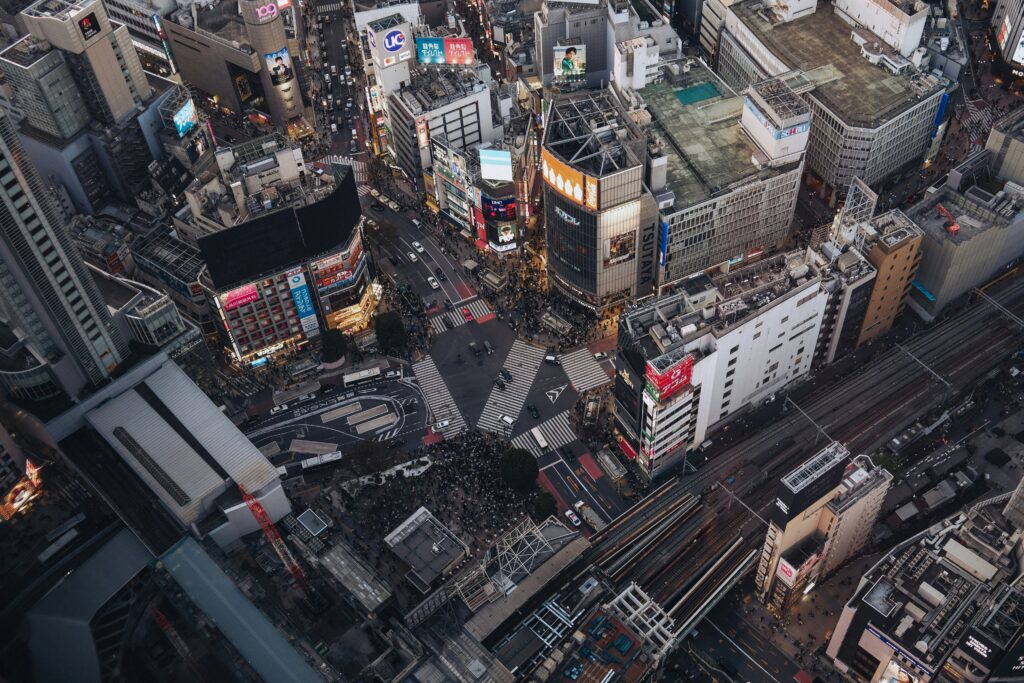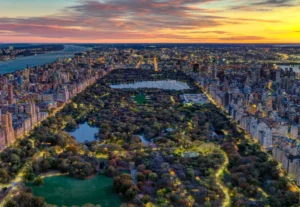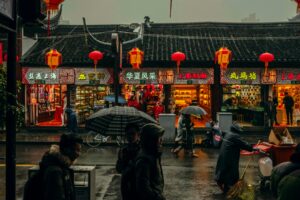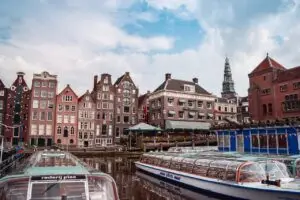I’ll never forget my first moment in Tokyo: stepping out of Shibuya Station at dusk, following the crowd up the stairs, and suddenly finding myself at the edge of the world’s busiest pedestrian crossing. The lights changed, and thousands of people surged forward from all directions in a perfectly choreographed chaos that somehow just worked. Neon signs blazed overhead, the energy was electric, and I knew immediately that Tokyo was unlike anywhere else on Earth. That moment of sensory overload transformed into pure wonder, and it’s a feeling that keeps drawing travelers back to this extraordinary city.
As we move through 2025, Tokyo has emerged from recent global challenges more accessible and traveler-friendly than ever. The city has expanded English signage, embraced more cashless payment options, and yet somehow retained the authentic cultural experiences that make it so special. Whether you’re planning your first visit or returning to explore deeper layers of this endlessly fascinating metropolis, understanding the top 10 places to visit in Tokyo will transform your trip from good to unforgettable.
In this comprehensive guide, you’ll discover not just the must-see attractions but the stories behind them, practical tips for navigating each location like a local, money-saving strategies, hidden gems that most tourists miss, and answers to all the questions first-time visitors ask. From ancient temples to futuristic digital art museums, from serene gardens to buzzing entertainment districts, we’ll cover everything you need to experience the best of Tokyo.
TL;DR – Quick Links to Top 10 Places:
- Meiji Shrine & Yoyogi Park (Google Maps)
- Senso-ji Temple & Nakamise Street (Asakusa) (Google Maps)
- Tokyo Skytree (Google Maps)
- Shibuya Crossing & Shibuya Sky (Google Maps)
- Tokyo Tower & Zojoji Temple (Google Maps)
- Imperial Palace East Gardens (Google Maps)
- teamLab Planets TOKYO (Google Maps)
- Akihabara (Electric Town) (Google Maps)
- Takeshita Street (Harajuku) & Omotesando (Google Maps)
- Odaiba & Rainbow Bridge (Google Maps)
Tokyo stands as one of the world’s most captivating destinations, a sprawling metropolis where ancient temples sit comfortably alongside neon-lit skyscrapers, and centuries-old traditions blend seamlessly with cutting-edge technology. Whether you’re planning your first visit or returning to discover more of this incredible city, knowing the top 10 places to visit in Tokyo will help you make the most of your Japanese adventure.
Why Visit Tokyo Today
Tokyo isn’t just another bustling capital; it’s a city that defies simple categorization. The unique blend of tradition and innovation creates an atmosphere you won’t find anywhere else on Earth. Walk through the serene grounds of a 400-year-old shrine in the morning, then lose yourself in the electric energy of futuristic entertainment districts by night. This juxtaposition isn’t jarring; instead, it feels perfectly natural, a testament to Tokyo’s ability to honor its past while embracing the future.
Safety and efficiency are hallmarks of the Tokyo experience. The city consistently ranks among the safest major metropolitan areas globally, with crime rates that make even solo travelers feel comfortable exploring at any hour. The public transportation system operates with legendary precision, where trains arrive on schedule down to the minute, and station staff go above and beyond to help visitors navigate the extensive network. English signage has improved dramatically in recent years, making Tokyo increasingly traveler-friendly for international guests.
The seasonal transformations add another layer of magic to visiting the top 10 places in Tokyo Japan. Spring brings the legendary cherry blossom season, typically from late March through early April, when parks and temple grounds explode in clouds of delicate pink and white. Summer festivals light up neighborhoods with traditional dances, street food stalls, and spectacular fireworks displays. Autumn paints the city in brilliant reds and golds, particularly stunning in the many gardens and parks. Even winter has its charm, with illumination displays transforming the city into a wonderland of lights, and the occasional snowfall adding a peaceful blanket to temple roofs and traditional neighborhoods.
Tokyo’s food scene alone justifies the journey. From humble convenience store snacks that somehow taste gourmet to Michelin-starred establishments serving exquisite kaiseki cuisine, the city offers culinary experiences at every price point and sophistication level. The attention to detail, quality of ingredients, and dedication to craft elevate even the simplest bowl of ramen or plate of sushi into something memorable.
Top 10 Places to Visit & See in Tokyo
1. Meiji Shrine & Yoyogi Park
Stepping through the towering torii gate into Meiji Shrine feels like entering another world, despite being minutes from Harajuku’s bustling streets. This Shinto shrine, dedicated to Emperor Meiji and Empress Shoken, sits within a 175-acre forest of over 100,000 trees donated from across Japan. The approach along gravel paths beneath the forest canopy provides a meditative transition from the urban energy outside.
The shrine’s main buildings, reconstructed after World War II, embody traditional Japanese architectural elegance with their copper-clad roofs and cypress wood construction. Visitors can observe or participate in traditional rituals: writing wishes on wooden ema plaques, purchasing omamori protective charms, or witnessing wedding processions in traditional dress. The treasure museum displays personal belongings of the imperial couple, offering glimpses into Meiji-era history. For detailed visiting hours and special events, check the official Meiji Shrine website.
Adjacent Yoyogi Park transforms the experience from spiritual to social. On weekends, the park becomes Tokyo’s living room, where locals gather for picnics, street performances, and impromptu music sessions. Rockabilly dancers practice their moves near the entrance, while families spread blankets beneath cherry trees. The contrast between the shrine’s solemnity and the park’s vibrant energy perfectly captures Tokyo’s duality. Early morning visits to the shrine offer tranquility before crowds arrive, while the park hits its stride on Sunday afternoons.
2. Senso-ji Temple (Asakusa) & Nakamise Street
Asakusa preserves the atmosphere of old Edo, and Senso-ji Temple stands as Tokyo’s oldest and most significant Buddhist temple. Legend dates its founding to 628 CE, when two fishermen discovered a golden statue of Kannon, the goddess of mercy, in the nearby Sumida River. Today, the Kaminarimon (Thunder Gate) with its massive red lantern serves as one of Tokyo’s most photographed landmarks.
Walking through Kaminarimon begins a sensory journey along Nakamise Street, a 250-meter shopping arcade that has served temple visitors for centuries. Modern storefronts sell traditional snacks like ningyo-yaki (small cakes filled with red bean paste), crispy senbei rice crackers, and colorful wagashi confections alongside souvenirs ranging from elegant folding fans to playful keychains. The aroma of freshly grilled mochi and sweet treats fills the air, while vendors call out to passersby in time-honored fashion.
The main temple hall, reconstructed after wartime destruction, impresses with its grand scale and ornate details. Before entering, visitors traditionally cleanse themselves at the purification fountain and wave incense smoke over their bodies for healing. The adjacent five-story pagoda and various smaller shrines reward exploration. Visit at dawn to see worshippers performing their daily devotions, or return in the evening when illumination creates dramatic shadows. The surrounding Asakusa neighborhood offers traditional restaurants, street food stalls, and riverside walks along the Sumida.
3. Tokyo Skytree / Observation Decks
Tokyo Skytree dominates the eastern skyline at 634 meters, making it the world’s tallest tower and Japan’s tallest structure. The height isn’t arbitrary; 634 can be read as “musashi,” the old name for the Tokyo region. The tower’s design incorporates traditional Japanese aesthetics into its futuristic form, with a shape inspired by temple columns and a color called “Skytree White” evoking traditional Japanese beauty.
Two observation decks offer different perspectives. The Tembo Deck at 350 meters provides stunning 360-degree views across Tokyo, with landmarks clearly visible on clear days: Mount Fuji to the west, Tokyo Bay to the east, and the sprawling metropolis in every direction. The higher Tembo Galleria at 450 meters features a spiral glass corridor creating the sensation of walking through the sky. Interactive displays identify landmarks, while glass floor sections let brave visitors peer straight down. Book tickets in advance through the Tokyo Skytree official website to skip long queues.
The Skytree Town complex at the tower’s base justifies hours of exploration beyond the observation decks. Tokyo Solamachi shopping center houses over 300 shops and restaurants spanning multiple floors, while the Sumida Aquarium showcases marine life in innovative exhibits. A planetarium, numerous themed cafes, and seasonal events make the complex family-friendly. Advance online tickets help avoid long queues, particularly during holidays and weekends. Evening visits reward with the magical transformation as Tokyo’s lights begin twinkling across the urban landscape.
4. Shibuya Crossing & Shibuya Sky
No intersection symbolizes Tokyo’s organized chaos quite like Shibuya Crossing. When the lights change, up to 3,000 people surge across from all directions in a perfectly choreographed yet spontaneous dance. The experience captures Tokyo’s essence: massive crowds moving in apparent disorder that somehow flows without collision. Watch from ground level to feel the energy, or head to second-floor Starbucks windows for an aerial perspective of the human river flowing below.

The crossing represents the heart of Shibuya, a district pulsing with youth culture, fashion, and entertainment. Neighboring streets like Spain-zaka and Center-gai overflow with boutiques, vintage shops, karaoke boxes, and izakaya bars. The famous Hachiko statue nearby commemorates the loyal dog who waited for his deceased owner every day, now a popular meeting spot where friends gather beneath the faithful companion’s bronze gaze.
Shibuya Sky, opened in 2019, offers the district’s most spectacular viewing experience. Unlike enclosed observation decks, the rooftop Sky Stage at 230 meters provides open-air access, letting you feel the wind and hear the city’s distant hum. Hammocks and seating areas encourage lingering to watch the sunset paint the sky, followed by the gradual illumination of the city below. The indoor Sky Gallery features interactive exhibits and installations. The three-level experience includes the ground-level Sky Gate entrance, mid-level Sky Gallery, and the crowning Sky Stage, each offering different perspectives on this vertical journey.
5. Tokyo Tower & Zojoji Temple
Tokyo Tower predates its taller cousin Skytree by over 50 years, yet this 333-meter orange-and-white lattice structure remains beloved for its nostalgic charm and central location. Inspired by the Eiffel Tower but taller, it has symbolized Japan’s post-war recovery and technological advancement since 1958. The main observation deck at 150 meters and top deck at 250 meters deliver sweeping views across central Tokyo, with Mount Fuji visible on exceptionally clear days.
What sets Tokyo Tower apart is its location amid parks and historic sites, creating layered sightseeing opportunities. The tower’s base houses museums, cafes, and shops, while special illuminations change seasonally, painting the structure in various colors from romantic pink to patriotic red and white. Night visits offer romantic city views, while day visits maximize landmark spotting.
Zojoji Temple sits at the tower’s feet, providing stunning photo opportunities of ancient and modern architecture side by side. This important Tokugawa family temple dates to 1393, though current buildings are post-war reconstructions. Six shoguns rest in the temple cemetery, and the grounds feature rows of small Jizo statues representing deceased children, dressed in colorful bibs and caps by grieving parents. The main hall impresses with its scale and ornate interior. The temple’s morning prayers and afternoon ceremonies welcome respectful observers. Cherry blossom season transforms the grounds into particularly photogenic scenes, with tower and temple framed by pink blooms.
6. Imperial Palace & East Gardens
The Imperial Palace sits on the former site of Edo Castle, the shogunate’s headquarters that grew into present-day Tokyo. The current emperor and imperial family reside here, making most grounds off-limits except for organized tours on specific dates. However, the atmosphere of walking around the moat-encircled palace grounds offers peace impossible elsewhere in central Tokyo. The massive stone walls, ancient bridges, and perfectly maintained trees create timeless scenery, popular with joggers making the roughly five-kilometer circuit.
The East Gardens (Higashi Gyoen) provide the most accessible palace experience, open to the public free of charge throughout the week. These former castle grounds now function as a spacious public park showcasing careful landscape design through all seasons. Remains of the old castle foundation, guardhouses, and stone walls help visitors imagine the fortress that once stood here. The carefully maintained lawns, traditional gardens, and tree-lined paths offer tranquility despite the surrounding business district’s energy.
Seasonal transformations make repeat visits worthwhile. Spring cherry blossoms create breathtaking scenes along the moat, while azaleas bloom in brilliant colors through May. Summer’s lush greenery provides welcome shade, and autumn delivers spectacular foliage displays. Winter’s bare branches reveal the grounds’ architectural bones while camellias add color. The palace museums display imperial treasures and artifacts, though access requires advance booking. The nearby Chidorigafuchi moat becomes particularly spectacular during cherry blossom season, with rental boats allowing water-level flower viewing.
7. teamLab Planets / Borderless
Tokyo’s digital art museums have revolutionized how we experience art, and teamLab’s installations push boundaries further than anywhere else. teamLab Planets in Toyosu creates immersive environments where visitors walk through water, interact with living digital flowers, and lose themselves in infinite mirror rooms. You’ll wade barefoot through knee-deep water as koi fish swim around your legs, digitally projected and responsive to your movements. In another space, thousands of LED flowers bloom and die in cycles influenced by viewer presence.
The experience deliberately disorients and amazes. Mirrored surfaces create infinite reflections, soft flooring makes you feel ungrounded, and the combination of water, light, and your own reflection blurs reality’s edges. Each room offers different sensations, from the gentle touch of digital butterflies to the overwhelming presence of massive hanging installations. Photography is encouraged, and indeed the spaces seem designed for sharing, though the real magic lies in direct experience.
teamLab Borderless in Azabudai Hills (relocated from Odaiba in 2024) takes a different approach with artworks that move freely through the museum space, interacting with other pieces and visitors. The athletic forest section lets children and adults play on interactive trampolines and climbing structures. The crystal light installations create mesmerizing environments where thousands of LED points create ever-changing patterns. Book tickets in advance through the teamLab official website as these popular attractions regularly sell out, especially during holidays and weekends. Visiting during weekday mornings offers less crowded conditions and better opportunities for contemplative viewing and unobstructed photography.
8. Akihabara (Electric Town)
Akihabara represents Tokyo’s otaku culture in concentrated form. What began as a post-war black market for radio parts evolved into the global center for electronics, anime, manga, and video games. Multi-story shops like Yodobashi Camera and BicCamera pack every imaginable electronic device and gadget across multiple floors. Retro game stores sell classic consoles and cartridges, while arcades offer everything from nostalgic classics to cutting-edge virtual reality experiences.
The district’s anime and manga culture manifests everywhere: storefronts feature larger-than-life character illustrations, maid cafes invite visitors for themed refreshments served by costumed staff, and specialty shops dedicate entire floors to figures, collectibles, and merchandise from specific series. Mandarake’s multiple locations house used manga, doujinshi, and rare collectibles. Animate and similar chains offer the latest releases. Gashapon (capsule toy) hallways present walls of machines dispensing miniature collectibles.
Walking Akihabara’s main drag and side streets reveals layer upon layer of subcultures. Electronics parts stores still exist, serving hobbyists and tinkerers. Idol concerts happen in small venues, while VR arcades let visitors experience virtual worlds. The area feels most alive during evenings when lights blaze and crowds of enthusiasts fill the streets. Sunday afternoons bring street performers and vendors. Whether you’re deeply embedded in otaku culture or simply curious, Akihabara offers fascinating glimpses into passionate fan communities and the technologies shaping future entertainment.
9. Harajuku / Takeshita Street & Omotesando
Harajuku epitomizes Tokyo’s youth culture and fashion scene. Takeshita Street, a narrow pedestrian lane, packs more trendy shops, crepe stands, and photo opportunities into a few hundred meters than seems physically possible. Teenagers and tourists alike crowd the street hunting for affordable fashion, quirky accessories, and Instagram-worthy rainbow-colored foods. Crepe stands serve stuffed confections loaded with cream, fruit, and candy. Clothing stores specialize in everything from gothic lolita fashion to streetwear, with prices generally accessible to young shoppers.
The atmosphere bursts with energy and experimental style. Street fashion here influenced global trends, and you’ll still see creative outfits that push boundaries. Side streets branch off with more specialized shops, vintage stores, and themed cafes ranging from hedgehog cafes to establishments dedicated to specific anime series. The compressed intensity can overwhelm, so venture to calmer areas when needed.
Omotesando provides a stark contrast mere minutes away. This tree-lined boulevard, often called Tokyo’s Champs-Élysées, showcases high-end fashion in architecturally significant buildings. Flagship stores for international luxury brands occupy structures designed by renowned architects like Tadao Ando, Toyo Ito, and Herzog & de Meuron. Even window shopping becomes cultural education here. Side streets hide gems like Ura-Harajuku (backstreets Harajuku) with independent boutiques and cafes frequenting by fashion insiders. The area demonstrates Tokyo’s range, from accessible teen culture to sophisticated luxury, often within a single neighborhood.
10. Odaiba & Rainbow Bridge
Odaiba, a collection of artificial islands in Tokyo Bay, represents the city’s vision of the future. Developed primarily in the 1990s, this waterfront district combines shopping, entertainment, museums, and recreation with bay and skyline views. The futuristic atmosphere begins with arrival via the driverless Yurikamome elevated train, which offers panoramic views as it crosses Rainbow Bridge.
The district centers on massive shopping and entertainment complexes. DiverCity Tokyo Plaza features a life-size Unicorn Gundam statue that transforms with light and sound shows. Palette Town houses teamLab Borderless (until its relocation) and a giant Ferris wheel offering panoramic bay views. Aqua City Odaiba combines shopping with bay-side restaurants and a view of Rainbow Bridge. Museums cater to various interests: the National Museum of Emerging Science and Innovation (Miraikan) explores cutting-edge technology, while the Toyota Mega Web showcases automotive innovation and offers test drives.
Odaiba Seaside Park provides the closest beach experience within Tokyo, with views across the bay to central Tokyo’s skyline. The replica Statue of Liberty adds unexpected photo opportunities. Evening visits reward with Rainbow Bridge’s illuminations, which change colors seasonally. The bridge itself offers pedestrian walkways (weather permitting) for those wanting to walk between Odaiba and mainland Tokyo while enjoying unique perspectives. Odaiba’s somewhat isolated location makes it ideal for a half-day or evening excursion, particularly as the sunset transforms the bay’s atmosphere.
Local Tips & Practical Info
Best Times to Visit
Tokyo welcomes visitors year-round, but timing impacts your experience significantly. Spring (March to May) brings legendary cherry blossoms and comfortable temperatures, but also peak crowds and premium prices. The official bloom forecast varies yearly, typically hitting Tokyo late March to early April. Autumn (September to November) rivals spring with pleasant weather, stunning fall foliage, and manageable crowds. October and November offer particularly stable weather and spectacular red maple displays.
Summer (June to August) brings heat, humidity, and occasional typhoons, particularly during the rainy season in June and early July. However, summer festivals and fireworks displays add cultural experiences, and air conditioning everywhere makes indoor exploration comfortable. Winter (December to February) sees fewer tourists, with dry, cold weather and occasional snow. Illuminations transform the city during the holiday season, while New Year brings fascinating temple visits and traditional celebrations.
Where to Stay
Location matters enormously in a city of Tokyo’s size. First-time visitors typically favor staying near major transit hubs for convenience. Shinjuku offers massive station connections, endless dining options, and proximity to western Tokyo attractions. Shibuya provides similar benefits with a younger, hipper atmosphere. Tokyo Station or nearby Ginza position you centrally with easy airport access and proximity to the Imperial Palace and upscale shopping.
Asakusa delivers traditional atmosphere and proximity to Senso-ji Temple while maintaining good transit connections and often better value than central wards. Ueno similarly combines cultural attractions with practical location and reasonable prices. For those seeking quieter bases, residential areas like Nakameguro or Kichijoji offer local flavor with quick train access to major sights.
Accommodation ranges from capsule hotels for budget travelers to luxury international chains. Business hotels provide excellent mid-range value with small but efficient rooms, typically including amenities like free WiFi, toiletries, and sometimes breakfast. Traditional ryokan inns offer cultural experiences, though few exist in central Tokyo. Book well in advance during cherry blossom season, Golden Week (late April/early May), and New Year holidays.
Getting Around
Tokyo’s public transportation network deserves its legendary reputation. The combination of JR lines (including the essential Yamanote loop line), private railways, and extensive subway systems reaches virtually everywhere. Suica and Pasmo IC cards function identically for transit, purchased and recharged at station machines. Tap on entry and exit, and the system automatically deducts the correct fare. Learn more about navigating Tokyo’s transit system on the official Tokyo Metro website.
The Yamanote Line loop connects major stations like Tokyo, Shinjuku, Shibuya, and Ueno, making it invaluable for visitors. Most top 10 places in Tokyo connect easily to this line or stations along it. The Tokyo Metro and Toei subway lines reach everywhere else. Station signs include English, and Google Maps provides accurate route planning including platform numbers and exit information.
Trains run roughly 5 AM to midnight, with last trains around 12:30 AM. Missing the last train means expensive taxis or waiting until morning service resumes. Rush hours (roughly 7:30-9:30 AM and 5:30-7:30 PM) bring intense crowding on major lines. Taxis exist but cost considerably more than trains, better saved for late nights or multiple passengers splitting fares. Walking between nearby stations often proves faster than navigating transfers, and you’ll discover more of the city at street level.
Cultural Etiquette
Understanding basic etiquette enhances your experience and shows respect. Remove shoes when entering homes, traditional restaurants, temples, and any space with tatami mats. Slippers are typically provided. Don’t walk around in toilet slippers; they stay in the bathroom.
Train etiquette includes standing to the left on escalators, maintaining quiet voices, and absolutely not talking on phones. Priority seating exists for elderly, pregnant, or disabled passengers. Eating while walking is generally frowned upon; enjoy street food near where you purchased it. Tipping isn’t practiced and can cause confusion; the price is the price.
Bowing serves various purposes from greeting to apology to gratitude, though foreign visitors aren’t expected to master complex forms. A slight head nod acknowledges service. When visiting temples and shrines, observe others and follow their lead for proper purification and prayer methods. Photography is generally welcome except where posted otherwise or during ceremonies.
Day Trips From Tokyo
Tokyo’s central location enables numerous day trip options. Nikko, roughly two hours north, offers spectacular shrine and temple complexes amid mountain scenery, including the famous Toshogu Shrine. Kamakura, about an hour south, delivers the Great Buddha statue, numerous temples, and beach atmosphere. Hakone provides hot springs, mountain scenery, and Mount Fuji views, accessible as a day trip though overnight stays maximize the experience. For comprehensive day trip planning, visit Japan Guide’s day trips section.
Mount Fuji itself sits roughly 2-3 hours away depending on your destination. The Fifth Station provides mountain access during climbing season (July-September), while surrounding areas offer views and resort facilities year-round. Yokohama, just 30 minutes south, features China Town, waterfront attractions, and museums. The historic capital Kyoto lies 2.5 hours away via shinkansen bullet train, possible as a very long day trip though multiple days do it justice.
Budgeting & Money-Saving Advice
Sample Daily Budgets
Tokyo accommodates various budget levels, though it generally costs more than other Asian destinations and comparably to other major global cities. Budget travelers can survive on 6,000-8,000 yen daily ($40-55 USD) through hostel accommodation, convenience store meals, and free or cheap attractions. Mid-range travelers should budget 15,000-25,000 yen daily ($100-170 USD) covering business hotel accommodation, mix of convenience store and restaurant meals, and paid attractions. Luxury travelers can easily spend 40,000 yen and up ($270+ USD) on upscale hotels, fine dining, and premium experiences.
Accommodation represents the largest expense, ranging from 2,500 yen for hostel dorms to 15,000+ yen for hotels and much higher for luxury properties. Food costs vary wildly: convenience store meals run 300-500 yen, casual restaurants 800-1,500 yen, and upscale dining can reach tens of thousands per meal. Attraction admission typically ranges from free (many shrines, parks, and gardens) to 2,000-3,000 yen for major sites. Transportation adds 800-1,500 yen daily for typical sightseeing.
Free and Cheap Attractions
Many of Tokyo’s most memorable experiences cost little or nothing. The Imperial Palace East Gardens, Meiji Shrine grounds (inner garden costs 500 yen), Senso-ji Temple, and major parks like Yoyogi and Ueno all welcome visitors free. Shrines and temples across the city rarely charge admission, though special gardens or buildings within complexes may.
Walking tours led by volunteers or self-guided exploration of neighborhoods like Yanaka, Shimokitazawa, or Daikanyama cost nothing and reveal local life. The observation deck in the Tokyo Metropolitan Government Building in Shinjuku provides free city views to rival paid towers. Department store food halls (depachika) offer free samples and fascinating displays of Japanese food culture without requiring purchases.
Budget-friendly attractions include neighborhood public baths (sento) around 500 yen, karaoke boxes starting around 500 yen per person per hour (outside peak times), and various municipal museums with sub-500 yen admission. Many major museums offer free admission days monthly or reduced rates for students and seniors.
Discount Passes
Several passes offer savings for heavy transit users or museum enthusiasts. The Tokyo Metro 24/48/72-hour passes provide unlimited subway rides, useful if making many trips daily though the 72-hour pass at 1,500 yen requires significant use to beat individual fares. The JR Tokyo Wide Pass covers broader areas including day trip destinations, worthwhile if visiting Nikko, Hakone, or Mount Fuji areas.
The Grutt Pass provides one free or discounted admission to around 100 Tokyo museums and attractions for 2,500 yen, valid two months. Calculate whether your planned visits justify the cost, as individual admissions for three or four major sites approach the pass price. Some attractions offer late afternoon discount tickets or combination tickets with nearby sites.
Convenience Store Hacks
Convenience stores (konbini) like 7-Eleven, FamilyMart, and Lawson function as lifesavers for budget travelers. Beyond their obvious use for snacks and drinks, they offer surprisingly good onigiri rice balls (100-150 yen), sandwiches, salads, and hot foods including fried chicken and nikuman steamed buns. Freshly brewed coffee rivals dedicated coffee shops at a fraction of the price.
Many konbini provide ATMs accepting foreign cards (7-Eleven and postal ATMs most reliable), copy and printing services, bill payment options, and even concert ticket sales. Free WiFi, clean bathrooms, and trash bins (rare on Tokyo streets) add utility. The prepared foods refresh multiple times daily, with discount stickers appearing on items approaching expiration; shop late evening for deals though selection diminishes.
Hidden Gems & Insider Picks
Kichijoji & Inokashira Park
Consistently voted as where Tokyo residents most want to live, Kichijoji delivers neighborhood atmosphere with convenient shopping and dining. The covered Sunroad and Daiya streets offer local shops and restaurants avoiding tourist prices. Inokashira Park spreads around a central pond perfect for swan boat rentals, with particularly stunning cherry blossom displays in spring and foliage in autumn. The park also houses the Ghibli Museum, requiring advance reservations but rewarding Studio Ghibli fans with delightful exhibits and exclusive short films.
The area’s residential feel provides authentic glimpses of Tokyo life beyond major tourist zones. Independent coffee shops, vintage stores, and casual izakaya outnumber chain establishments. The neighborhood’s walkability and concentration of interesting spots within small areas make it ideal for leisurely afternoon exploration without rigid plans. The Ghibli Museum requires advance ticket reservations, which can be purchased online through authorized vendors.
Yanaka & Nezu Neighborhoods
These adjacent neighborhoods survived both the 1923 earthquake and World War II bombing, preserving pre-war Tokyo atmosphere increasingly rare in the rebuilt city. Narrow streets wind past traditional wooden houses, small temples, and family-run shops that have served the community for generations. Yanaka Cemetery becomes particularly atmospheric during cherry blossom season, when locals picnic beneath the blooms in surprisingly peaceful settings.
Yanaka Ginza shopping street epitomizes the old downtown feel with mom-and-pop stores selling traditional crafts, snacks, and daily necessities. Cat statues and actual felines populate the area, earning it the nickname “cat town.” The neighborhood rewards aimless wandering rather than specific destination seeking. Stop for coffee at vintage kissaten cafes, browse craft shops selling handmade goods, and observe daily life in one of Tokyo’s most livable areas.
Edo-Tokyo Open Air Museum
Located in Koganei Park in western Tokyo, this open-air museum preserves and displays historical buildings from the Edo period through early Showa era. Actual structures were relocated and reconstructed here, creating a village-like atmosphere where visitors can enter merchant homes, farmhouses, traditional shops, and even a public bath house. The attention to detail extends to furnished interiors showing how people lived in different eras and social classes.
The museum offers tangible history unavailable in conventional museums. You can walk through a wealthy merchant’s home, peer into a traditional dyer’s workshop, explore the home of the architect who designed the Imperial Hotel, and see how bathhouses functioned as social centers. Volunteer guides sometimes demonstrate traditional crafts. The museum requires more effort to reach than central attractions but rewards with authentic historical immersion and usually manageable crowds.
Hie Shrine
This beautiful shrine on a hill in the Nagatacho district near the Imperial Palace serves as one of the most important in Tokyo, though far fewer tourists visit than Meiji Shrine. The approach via tunnel of red torii gates (similar to Kyoto’s famous Fushimi Inari) creates dramatic photo opportunities and atmospheric walks. The shrine serves as guardian to Tokyo, with a history dating to the 14th century and strong connections to the Tokugawa shogunate.
The grounds offer peace and views despite the central location near government buildings. The annual Sanno Matsuri in mid-June ranks among Tokyo’s most important festivals. Monkeys serve as shrine messengers, and you’ll find monkey-themed omamori charms and decorations. The combination of important cultural status, beautiful grounds, and relative calm compared to more famous shrines makes Hie particularly rewarding for those interested in religious traditions without overwhelming crowds.
Seasonal Insider Spots
Beyond the famous cherry blossom spots, locals favor less crowded viewing locations. Meguro River transforms into a pink tunnel of blossoms with riverside cafes and nighttime illuminations. Chidorigafuchi near the Imperial Palace allows boat rentals beneath the blooms. For autumn leaves, Rikugien Garden showcases brilliant colors in traditional landscape garden settings, while Meiji Jingu Gaien’s ginkgo avenue creates a golden tunnel in late November.
Summer brings outdoor beer gardens atop buildings across the city, offering pleasant evening atmosphere with city views. Fireworks displays like Sumidagawa Hanabi Taikai draw massive crowds but create spectacular experiences. Winter illuminations transform areas like Roppongi Hills, Shibuya’s Aoyama, and Caretta Shiodome into light wonderlands. Following seasonal events as locals do reveals Tokyo’s rhythms beyond permanent attractions.
Packing & Travel Hacks
Weather-Based Packing
Tokyo’s climate varies significantly across seasons, requiring different preparations. Spring and autumn bring mild temperatures but variable weather; pack layers with light jackets and perhaps an umbrella for occasional rain. Light, breathable clothing suits these transition seasons, with a mix of short and long sleeves providing flexibility as temperatures fluctuate throughout the day.
Summer demands light, breathable fabrics as heat and humidity peak. Japanese fashion tends conservative, but practicality wins; tourists in shorts and casual wear fit in fine. Air conditioning everywhere means keeping a light layer for indoor spaces. Sun protection including hats, sunglasses, and sunscreen helps, though these are easily purchased in Tokyo if forgotten. The rainy season brings frequent downpours; a compact umbrella (available at any convenience store) becomes essential.
Winter requires actual warm clothing with temperatures dropping near or below freezing, though rarely with heavy snow. A warm coat, scarves, and gloves make outdoor exploration comfortable. Buildings heat efficiently, so layers you can remove indoors work best. Comfortable, supportive walking shoes matter year-round as Tokyo exploration means lots of walking. Shoes you can slip on and off easily help at temples, traditional restaurants, and some other establishments.
Cash vs Card
Japan’s relationship with payment methods has evolved, but cash remains more important than in many Western countries. Major hotels, department stores, and larger restaurants accept international credit cards (Visa and Mastercard most widely), but smaller establishments, local restaurants, and many shops remain cash-only. Carry sufficient yen for daily needs including meals, snacks, and small purchases.
ATMs represent the easiest way to obtain cash. 7-Eleven ATMs and postal ATMs (found in post offices) most reliably accept foreign cards. Many bank ATMs don’t accept international cards or only operate during business hours. Withdrawal fees vary by your home bank, so understand your account’s international policies before traveling.
IC cards (Suica/Pasmo) work at convenience stores, vending machines, and many casual restaurants beyond just transit, functioning as stored-value payment methods. Loading these with cash extends your electronic payment options. Mobile payment services like PayPay have grown popular among locals but require Japanese bank accounts, limiting use by tourists.
Essential Tech Tools
Google Maps provides the most reliable navigation tool for Tokyo, offering accurate transit directions, walking routes, and real-time train schedules with platform information. Download offline maps for backup though cellular data proves inexpensive. The Maps app shows business hours, reviews, and photos for most locations, serving as a comprehensive planning tool.
Translation apps help tremendously even with Tokyo’s increasing English signage. Google Translate’s camera function lets you photograph Japanese text for instant translation, useful for menus, signs, and instructions. The conversation mode facilitates basic verbal communication, though Japanese people generally appreciate any attempt to speak basic Japanese phrases.
Pocket WiFi rentals provide unlimited data for multiple devices, available at airports or shipped to your accommodation. Alternatively, tourist SIM cards offer affordable data plans for unlocked phones. Both options prove more economical than international roaming for most carriers. Many hotels, cafes, and convenience stores offer free WiFi, though having your own connection provides flexibility and security.
Luggage forwarding services (takkyubin) let you ship bags between hotels or to/from airports for reasonable fees, freeing you from dragging suitcases on trains. Coin lockers at major stations store daypacks and small bags, useful for day trips or before hotel check-in. Download offline maps, save important addresses in Japanese, and screenshot key information before heading out each day.
FAQ — Top 10 Places to Visit & See in Tokyo
When is the best time to visit Tokyo?
The ideal time depends on your priorities. Spring (late March to May) offers cherry blossoms and pleasant weather but brings peak crowds and prices. Autumn (September to November) delivers comfortable temperatures, stunning fall foliage, and manageable tourist numbers, making it arguably the best overall season. Summer (June to August) means heat and humidity but features festivals and fireworks. Winter (December to February) sees fewer crowds and holiday illuminations, though temperatures drop near freezing.
How many days do I need to explore Tokyo properly?
A minimum of 4-5 days allows you to experience the top 10 places to visit in Tokyo without rushing. Seven to ten days provides breathing room for deeper exploration, day trips, and spontaneous discoveries. Two weeks lets you experience both major attractions and hidden neighborhoods while adopting a more relaxed pace. Even a brief 2-3 day stopover can capture Tokyo’s essence if you prioritize efficiently.
Should I visit Tokyo Skytree or Tokyo Tower?
Both offer unique experiences. Tokyo Skytree provides the highest views, modern facilities, and extensive shopping and dining complex at its base. Tokyo Tower offers nostalgic charm, central location near traditional sites like Zojoji Temple, and often shorter queues. Skytree suits those wanting the latest experience and highest vantage point, while Tokyo Tower appeals to those preferring classic Tokyo landmarks and easier access to other attractions. Budget travelers might skip both and visit the free Tokyo Metropolitan Government Building observation deck instead.
What day trips from Tokyo do you recommend?
Nikko offers spectacular shrines and mountain scenery about two hours away. Kamakura delivers temples, the Great Buddha, and coastal atmosphere within an hour. Hakone provides hot springs, art museums, and Mount Fuji views as a comfortable day trip or overnight stay. Mount Fuji’s Fifth Station allows closer mountain access during climbing season. Yokohama sits just 30 minutes away with its own distinct attractions. The historic capital Kyoto lies 2.5 hours away via shinkansen, possible as an ambitious day trip though better as an extended visit.
How expensive is visiting Tokyo?
Tokyo accommodates various budgets. Budget travelers can manage on $40-55 daily through hostels, convenience store meals, and free attractions. Mid-range visitors should plan $100-170 daily for business hotels, restaurant meals, and paid sights. Luxury travelers easily spend $270+ daily on upscale accommodations and dining. Transportation costs typically run $10-20 daily, attraction admissions range from free to $15-20 for major sites, and meals span from $3 convenience store options to unlimited high-end dining.
Where should first-time visitors stay in Tokyo?
Shinjuku offers excellent station connections, abundant dining, and proximity to western Tokyo attractions. Shibuya provides similar benefits with younger energy. Tokyo Station or Ginza areas position you centrally with easy airport access. Asakusa delivers traditional atmosphere near Senso-ji Temple with good transit connections and often better value. Ueno combines cultural sites with practical location and reasonable prices. All these areas offer efficient access to the top 10 places in Tokyo Japan while providing distinct neighborhood characteristics.
Do Tokyo attractions have specific opening hours I should know?
Most museums and paid attractions open around 9-10 AM and close between 4-6 PM, with last entry 30-60 minutes before closing. Temples and shrines generally allow grounds access dawn to dusk, though specific buildings may have limited hours. Shops typically open 10 AM-8 PM, with department stores closing around 8-9 PM. Restaurants serve lunch roughly 11:30 AM-2 PM and dinner 5:30-10 PM, though izakaya and casual spots often operate continuously. Many attractions close one day weekly, commonly Monday or Tuesday. Always check specific venues before visiting.
Is English sufficient for traveling in Tokyo?
Yes, though learning basic Japanese phrases enhances the experience. Major tourist areas, hotels, and attractions offer English signage and often English-speaking staff. Train stations display English on signs and announcements. However, smaller restaurants, local shops, and residential areas may have limited English. Translation apps, particularly camera-based ones for reading menus and signs, prove invaluable. Japanese people generally appreciate any attempt to speak their language, and most try helpfully to communicate despite language barriers. The city has become increasingly foreigner-friendly, making independent travel very manageable.
Ready to See Tokyo? Plan Your Adventure Now
The top 10 places to visit and see in Tokyo represent just the beginning of what this extraordinary city offers. From the serene forests surrounding Meiji Shrine to the pulsing energy of Shibuya Crossing, from the ancient traditions preserved at Senso-ji Temple to the digital wonderlands of teamLab, Tokyo rewards every type of traveler with experiences that stay with you long after you’ve returned home.
Each neighborhood reveals new layers, every season brings different colors and festivals, and the city’s unique blend of respect for tradition alongside embrace of innovation creates an atmosphere you won’t find anywhere else on Earth. Whether you’re drawn to cultural sites, cutting-edge technology, world-class cuisine, or simply the thrill of exploring one of the world’s greatest cities, Tokyo delivers beyond expectations.
Start planning your Tokyo adventure today by booking your accommodations early, particularly if visiting during cherry blossom season or major holidays. Research the specific attractions that interest you most, consider purchasing advance tickets for popular sites like teamLab and Tokyo Skytree, and don’t over-schedule yourself. Some of Tokyo’s best moments happen when you wander down unexpected side streets, stumble into local festivals, or discover tiny restaurants that become the highlight of your trip.
Want to explore more of Japan? Check out our comprehensive guide to day trips from Tokyo for adventures beyond the capital, or discover the top hidden gems across Japan that most travelers miss.
For official tourism information, updated attraction hours, and current events, visit the Go Tokyo official tourism website, the definitive resource for planning your Tokyo adventure.
What are you most excited to see in Tokyo? Have you visited any of these top 10 places? Share your experiences and questions in the comments below—we’d love to hear about your Tokyo adventures and help you plan your perfect trip!





